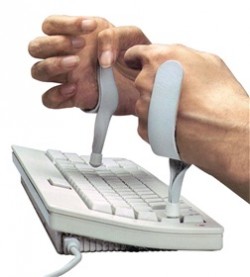Lecture 24 - Accessible Design
Slides based on content from Profs. Richard Ladner, Jake Wobbrock, and Amy Ko.
Disabilities
Everyone has different abilities
Nearly 1 in 5 People Have a Disability in the U.S. (from the U.S. Census)
(Some) kinds of disabilities
- Vision
- Blind
- Low-Vision
- Color Blind
- Hearing
- Deaf
- Hard of Hearing
- Speach
- Ability to speak
- Speach impediments
- Mobility
- Ability to Walk
- Ability to use limbs
- Cognative
- Dyslexia, dysgraphia, dyscalculia
- ADHD
- Memory loss
- Learning disabilities
- Behavioral
- Bipolar
Temporary and Situational disability
Disabilties can be temporary
- having a broken arm in a cast
- difficulty hearing after a loud concert
Disabilties can be situational
- trying to open your door while carrying groceries
- trying to talk on the phone in a noisy room
- trying to read your phone under direct sunlight
Disabilty affects all of us
Accessible design
Designs that account for all abilities are called accessible designs
Try your phone's screen reader!
Enable your phone's screen reader
- iOS: Settings > General > Accessibility > VoiceOver > Hit the switch
- Android: Settings > Accessibility > Talkback > Hit the switch
Input works differently now. For example, tap now reads the screen and double-tap selects. Use two or three fingers to scroll by page. Play with it for a minute.
Try closing your eyes and reading a webpage or a social networking site. Try writing an email.
Views of disabilities
Medical view
- Disabled people are patients who need treatment and/or cure.
Legal view
- Disabled people have rights and responsibilities, such as access to public buildings, voting, education, etc.
Sociocultural view
- Variation in ability is natural. "Disability" is caused by how society is designed, not by nature.
Universal Design
Design for as many users as possible, not just the average user
Example: Airplane cockpits:
- In 1952, the U.S. Air Force redesigned seats to fit the average pilot.
- They fit nobody (nobody is actually average), training results dropped.
- Redesigned seat to be configurable for any pilot; training results rose above previous levels.
Universal Design is often used in archetecture
Universal Design Principles
- Equitable use
- Flexibilty in use
- Simple and intuitive
- Perceptible information
- Tolerance for error
- Low physical effort
- Size and space for approach and use
Ability Based Design
Instead of focusing on the abilities that someone lacks (dis-ability), and trying to compensate
Focus on making systems work with what abilities people have
Don't make people adapt to the system 
Make the system adapt to the abilities of the user
Ability Based Design Principles
- Focus on Ability, not dis-ability.
- Accountability: If user has difficulty, system changes.
- Adaptation: Interface may be self-adaptive or user-adaptable.
- Transparency: Give user awareness of adaptations
- Performance: System may monitor users' performance
- Context: System may sense context
- Commodity: System may be affordable
First two are required, other five are recommended
Accessible Web design principles
Document structure: e.g., <article>, <strong>
Provide metadata: e.g., <html lang="en">
Provide alternatives: e.g., img alt tag, video captions, transcripts, allow both keyboard and mouse input
Avoid directional text: eg. "the diagram on the right shows..."
Note: These design prinicples help in other ways as well
- Captions allow people to watch your video without turning sound on.
- Transcripts help people find your page through Google.
- Structure and metadata help programs understand your page.
Tools and Resources
Web Content Accessibility Guidelines: https://www.w3.org/WAI/intro/wcag
Web Accessability Evaluation Tool: http://wave.webaim.org/
Color Schemes: http://colorbrewer2.org/
Color blindness checker: http://www.color-blindness.com/coblis-color-blindness-simulator/
Text readability: http://juicystudio.com/services/readability.php